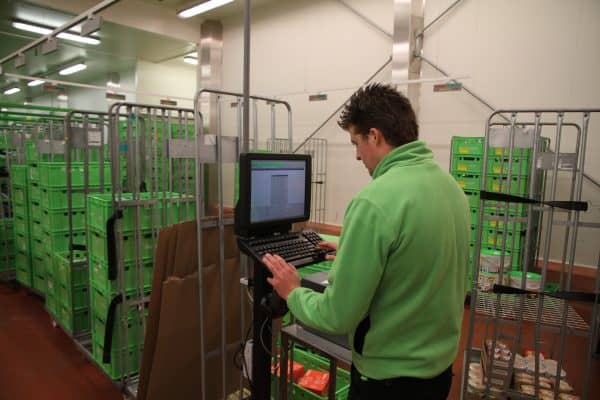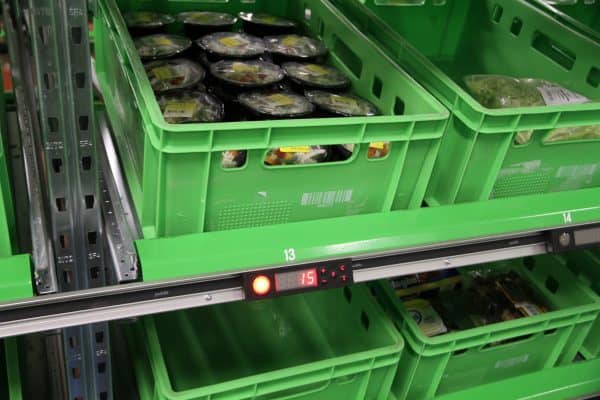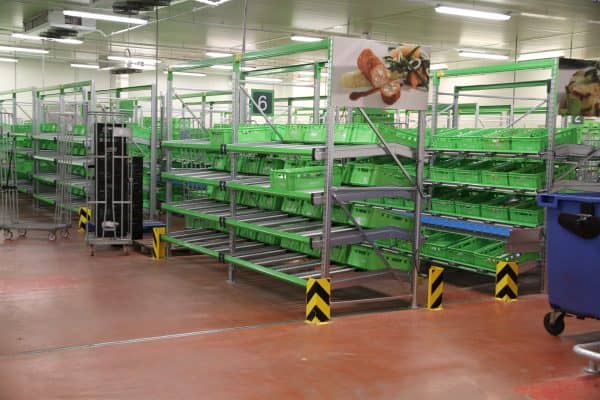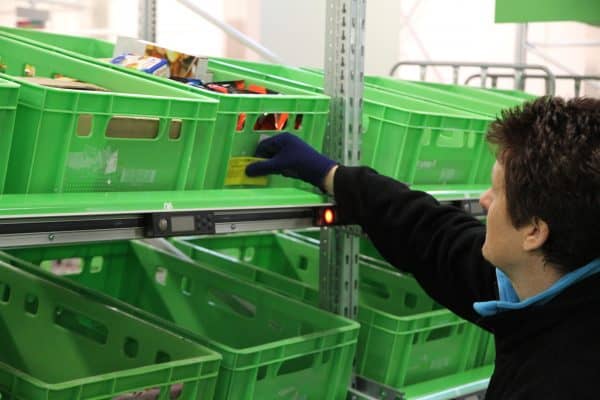Put to Light in the FMCG & Food sectors
The Distrivers food wholesale operation based in Hoogeveen, distributes fresh produce, food & beverages to a national client base across the Netherlands. On a daily basis, up to 80 operatives assem-ble and ship hundreds of orders in a highly pressurised, low lead time environment. Their growing customer base dictated that their existing picking solutions could no longer keep pace with their requi-rements, so they turned to Pcdata for a solution. Alongside this growth in demand, there was also a strong desire to be able to track & trace products being distributed to cus-tomers at crate level. After some consideration, the solution was
to be a new warehouse concept based on the Pcdata ‘Distrib’ WMS platform utilising the latest Put-to-Light technology.
The result of this deployment was a productivity growth of over 20%, significant space savings, a marked reduction in errors and of course, full registration of crate contents.
Prior to the implementation, Distrivers was not stranger to Pcdata solutions. Since 2003 the Hoogeveen based wholesaler had been utilising Put-to-Light (PTL) technology to provide daily order assembly for hundreds of hospitals and nursing homes with daily food and beverage.
Order Diversification
On a daily basis fresh produce and rea-dy meals are delivered to the Distrivers distribution centre and dispatched on the same day to all customer locations across the Netherlands.
Each customer location is connected to a Put-to-Light display which is then used to show the amount required of each product for each customer. Since 2003 the original PTL system of 288 light displays has been outgrown, with a greater number of individual delivery locations being served.
This growth was not simply driven by an increase in customers, but also by customer demand to split orders down into smaller segments. Many hospitals and care institutions now have multi-ple departments with their own distinct catering facilities, meaning that orders have to be broken down and delivered to each individual kitchen or depart-ment area. The effect of this means that where once there may have been one large order, there are now up to 20 smaller orders. In addition to this chan-ge of order demand, there was also no real method of tracking the content of each crate being delivered to these locations. The result of these changes meant that there was a significant issue with space, an increase in mistakes, a lack of efficiency and a failure to be able to properly track & trace product to customer.
“To serve all customers we had to work in two dispatching waves. Customers ordering only three crates occupied a complete floor location”, tells Sietse Buutkamp, operations Manager of Dist-rivers. “Some employees were walking nearly 10 kilometers a day along all put-to-light locations”, tells Richard Blauw-wiekel, operations Manager assistant of Distrivers.
Extracting Full Crates From Order Assembly
Two years ago, Distrivers decided to look for a solution to this ever increasing chal-lenge. Buutkamp and Blauwwiekel inves-tigated the possibilities of deploying other mechanization and automation solutions but finally returned to Pcdata, supplier of the original PTL system.
Using sophisticated methods of analy-sis, Pcdata developed a completely new warehouse concept, based on the Dist-rib WMS solution in combination with the latest PTL technology. “We knew that what we had was good in principle. A key advantage of using put-to-light again was that the employees were already familiar with the system and did not need any training. It is also a very easy process for new staff to learn”, tells Buutkamp.
The new concept has split the order as-sembly process into two phases: Pre-Despatch and End-Despatch. All inco-ming products are first Pre-Despatched to 12 End-Despatch locations. Each End-Despatch location contains a number of customer orders. At the point of Pre-Des-patch, the total number of single units for customers in each End-Despatch zone are put into trays, separating off the full crate volume at source.
Each End-Despatch zone then has a set of flow racking consisting of 64 customer locations where the single units can be assembled to orders. The full crates, having already being separated in the first phase, can be immediately labelled, taken to the outbound shipping area and marshalled ready for despatch. 70% of the total daily volume is in full crates, meaning that all these crates bypass the order assembly process altoge-ther: “This results in a tremendous reduction in work load at the end dispatch terminals”, said Blauwwiekel.









